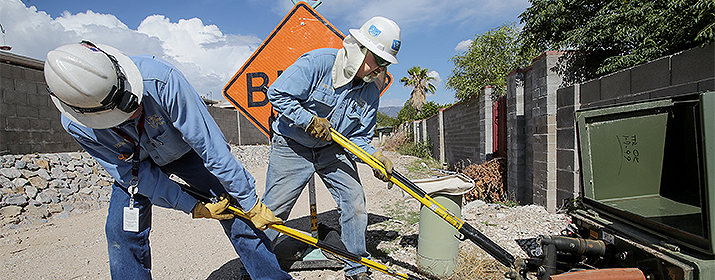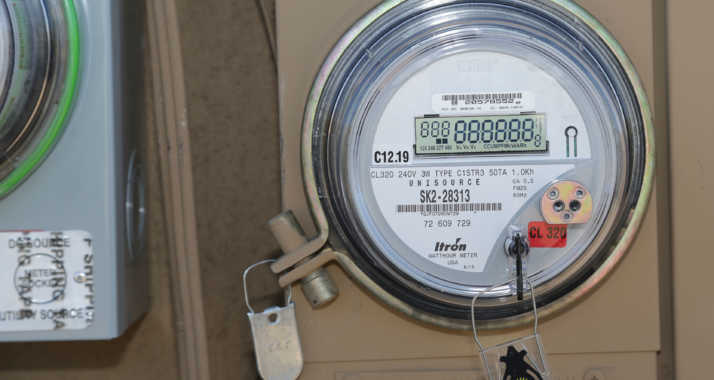

The two-way radio crackles inside Troubleman Gary Sanford’s bucket truck with an assignment from the system-control center: check out a power outage at a house in South Tucson. He writes the address neatly on a Steno notepad, shifts his truck into gear and heads briskly toward the customer’s home.
Sanford is one of Tucson Electric Power’s troublemen – electrical system experts who have years of specialized training and experience. Troublemen are TEP’s first-responders during emergencies and when the power goes out. They respond to 911 reports, downed wires, traffic accidents, multiple-pole “blow downs” and countless other types of calls.
“I enjoy the challenge of this job. I get to figure out and solve problems,” says Sanford, who has been a troubleman since 2008. “I love helping people get their power back on and reduce their level of stress.”
David White, Transmission & Distribution Superintendent, oversees the troublemen along with Team Lead Chris Dunnigan. “Troublemen are the cream of the crop,” White says.
Hard-Earned Expertise
A troubleman’s training can span a decade, or longer. First, he or she must become a journeyman lineman by working as a pre-apprentice for a year or two before entering a four-year, 8,000-hour apprenticeship. “Then comes the real-life experience,” says White, adding that it takes another five to 10 years to become truly proficient in electrical system repair.
Troublemen must pass a tough written test and an in-person interview and have a good safety record.
Sanford, who started at TEP in 1980, worked his way up through line construction to become a troubleman. As a journeyman lineman, he was part of an emergency crew for several years, making the repairs that followed a troubleman’s diagnosis.
For Sanford, the new job had a learning curve, even after more than two decades as a lineman. “When you’re a troubleman, you have to be a detective,” he said. “The job can be challenging.”
In the Field
TEP has troublemen in the field seven days a week, in two shifts, from 6 a.m. to 9 p.m., and they are on-call 24 hours a day. During peak periods – during summer monsoon storms, for example – additional troublemen, along with seasoned linemen, will work around the clock.
Troublemen are in constant communication with the system-control center through two-way radios. System-control supervisors dole out assignments and give the troublemen instructions while they’re in the field.
When TEP receives a 911 call through the police or fire departments, a troubleman will be en route to the scene within 15 minutes. These life-safety situations can be anything from a house fire where energized lines are involved to serious traffic accidents where power poles are hit or knocked down. “You never know when you’ll have an emergency and you have to be ready to respond,” Sanford says.
Once arriving at a scene, the troubleman’s initial job is to make it safe, both electrically and physically. Next, he assesses what is causing the outage and what is the quickest way to restore power to customers.
“They are our eyes and our ears in the field,” said Thomas Mills, Manager of Transmission & Distribution Operations. If it’s an easy fix, the troubleman will do the repairs on-scene. Examples of this include fixing wire connections and checking the integrity of leaning poles. Troublemen also do a lot of “switching,” a process through which electricity is rerouted to isolate the failed equipment and restore electricity to customers.
If the repairs are more complicated, a crew will be called in. “If it’s a single point – one pole, one transformer, one span of wire – the troubleman will call in and order the materials for the crew,” White says. “If the repair involves multiple points, a designer will be called in to make a repair plan. This way, the troubleman can go to his next high-priority call.”
The most difficult jobs, Sanford says, involve underground power outages: “They’re the hardest to deal with because you can’t see the cable. First you have to find the problem, which can be a challenge, and then you have to switch around it.”
Battling the Elements
A troubleman’s busy season starts in June, when temperatures start to heat up and the load on the electrical system increases. When heavy monsoon storms hit and outages occur, troublemen fight pouring rain and fierce wind to secure scenes and pinpoint problems.
Desert creatures also can present a challenge. Snakes and rats will burrow their way into equipment. “I opened a transformer once and a snake was looking back at me,” Troubleman Larry Bieberstein says.
“We have to take the bad with the good,” says Sanford.
And there is a lot of good.
The job offers a lot of variety, and flexibility. Sanford starts his workday from home; his “office” is the cab of his bucket truck. No two days are the same.
Connecting with Customers
Sanford spends a fair amount of time talking with customers. When possible, he briefs them about what he found after checking out their reported problem.
For the most part, customers are understanding and patient and sometimes offer beverages, cookies or ice cream for a job well done.
Says Sanford: “Putting people back in power is very rewarding.”






